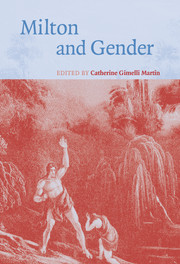Book contents
- Frontmatter
- Contents
- List of illustrations
- Notes on contributors
- Acknowledgments
- Abbreviations
- Introduction: Milton's gendered subjects
- PART I MASCULINITY, DIVORCE, AND MISOGYNY IN MILTON'S PROSE
- PART II THE GENDERED SUBJECTS OF MILTON'S MAJOR POEMS
- PART III GENDERED SUBJECTIVITY IN MILTON'S LITERARY HISTORY
- 11 George Eliot as a “Miltonist”: marriage and Milton in Middlemarch
- 12 Saying it with flowers: Jane Giraud's ecofeminist Paradise Lost (1846)
- 13 Woolf's allusion to Comus in The Voyage Out
- Index
13 - Woolf's allusion to Comus in The Voyage Out
Published online by Cambridge University Press: 22 September 2009
- Frontmatter
- Contents
- List of illustrations
- Notes on contributors
- Acknowledgments
- Abbreviations
- Introduction: Milton's gendered subjects
- PART I MASCULINITY, DIVORCE, AND MISOGYNY IN MILTON'S PROSE
- PART II THE GENDERED SUBJECTS OF MILTON'S MAJOR POEMS
- PART III GENDERED SUBJECTIVITY IN MILTON'S LITERARY HISTORY
- 11 George Eliot as a “Miltonist”: marriage and Milton in Middlemarch
- 12 Saying it with flowers: Jane Giraud's ecofeminist Paradise Lost (1846)
- 13 Woolf's allusion to Comus in The Voyage Out
- Index
Summary
In the final chapters of her first novel, The Voyage Out, Virginia Woolf's heroine, Rachel Vinrace, slides into a coma carrying the words of Milton's Comus with her. Shortly thereafter, she dies. In classic readings of this allusion, Milton is said to kill Rachel off in a book about books. The Voyage Out is thus read as a feminist metatext, one that seeks to rewrite the novel's violent marriage plot – a plot that has historically trapped, even “raped” women, denying them full humanity in their status as wives and mothers. Milton is often read as the baleful originator of this marriage plot and as the source of female oppression in the modern west. Having demanded in Paradise Lost that women submit to their husband's authority; having sentimentalized the private sphere and so locked early modern women into an asphyxiating domesticity; and, most importantly, having founded in Paradise Lost the middle-class novel with its woman-constricting marriage plot, Milton is read as the father of modern female doom. According to this reading, if things are to improve for women, Milton must be slain. So, in her first novel, Woolf takes on Milton in the form of her allusion to Comus, a work, like The Voyage Out, about the sexual violation of a female heroine. In plotting Milton as her first heroine's murderer, Woolf exposes and deconstructs the soul of the patriarchy Milton establishes, and, by implication at least, herself emerges as a master discourse writer of feminism.
- Type
- Chapter
- Information
- Milton and Gender , pp. 254 - 270Publisher: Cambridge University PressPrint publication year: 2005

